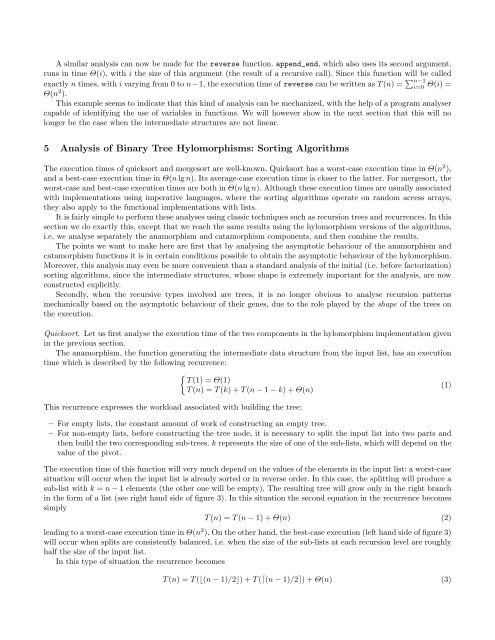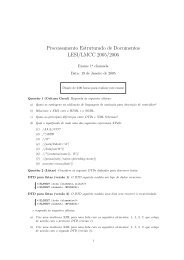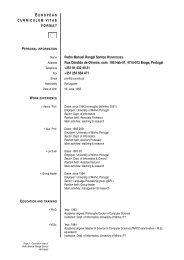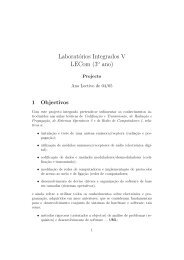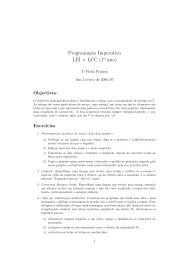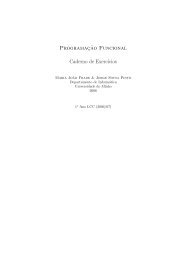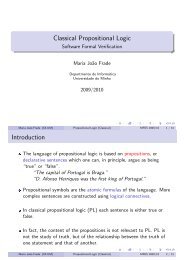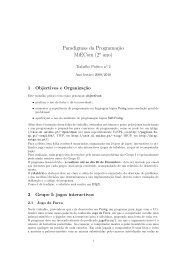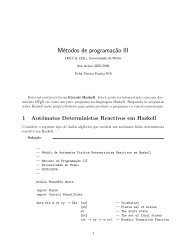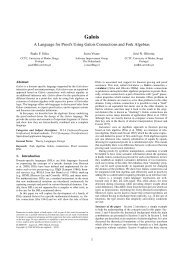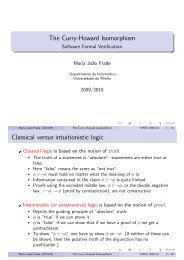Recursion Patterns and Time-analysis - Departamento de ...
Recursion Patterns and Time-analysis - Departamento de ...
Recursion Patterns and Time-analysis - Departamento de ...
You also want an ePaper? Increase the reach of your titles
YUMPU automatically turns print PDFs into web optimized ePapers that Google loves.
A similar <strong>analysis</strong> can now be ma<strong>de</strong> for the reverse function. append_end, which also uses its second argument,runs in time Θ(i), with i the size of this argument (the result of a recursive call). Since this function will be calle<strong>de</strong>xactly n times, with i varying from 0 to n−1, the execution time of reverse can be written as T (n) = ∑ n−1i=0 Θ(i) =Θ(n 2 ).This example seems to indicate that this kind of <strong>analysis</strong> can be mechanized, with the help of a program analysercapable of i<strong>de</strong>ntifying the use of variables in functions. We will however show in the next section that this will nolonger be the case when the intermediate structures are not linear.5 Analysis of Binary Tree Hylomorphisms: Sorting AlgorithmsThe execution times of quicksort <strong>and</strong> mergesort are well-known. Quicksort has a worst-case execution time in Θ(n 2 ),<strong>and</strong> a best-case execution time in Θ(n lg n). Its average-case execution time is closer to the latter. For mergesort, theworst-case <strong>and</strong> best-case execution times are both in Θ(n lg n). Although these execution times are usually associatedwith implementations using imperative languages, where the sorting algorithms operate on r<strong>and</strong>om access arrays,they also apply to the functional implementations with lists.It is fairly simple to perform these analyses using classic techniques such as recursion trees <strong>and</strong> recurrences. In thissection we do exactly this, except that we reach the same results using the hylomorphism versions of the algorithms,i.e, we analyse separately the anamorphism <strong>and</strong> catamorphism components, <strong>and</strong> then combine the results.The points we want to make here are first that by analysing the asymptotic behaviour of the anamorphism <strong>and</strong>catamorphism functions it is in certain conditions possible to obtain the asymptotic behaviour of the hylomorphism.Moreover, this <strong>analysis</strong> may even be more convenient than a st<strong>and</strong>ard <strong>analysis</strong> of the initial (i.e. before factorization)sorting algorithms, since the intermediate structures, whose shape is extremely important for the <strong>analysis</strong>, are nowconstructed explicitly.Secondly, when the recursive types involved are trees, it is no longer obvious to analyse recursion patternsmechanically based on the asymptotic behaviour of their genes, due to the role played by the shape of the trees onthe execution.Quicksort. Let us first analyse the execution time of the two components in the hylomorphism implementation givenin the previous section.The anamorphism, the function generating the intermediate data structure from the input list, has an executiontime which is <strong>de</strong>scribed by the following recurrence:{ T (1) = Θ(1)(1)T (n) = T (k) + T (n − 1 − k) + Θ(n)This recurrence expresses the workload associated with building the tree:– For empty lists, the constant amount of work of constructing an empty tree.– For non-empty lists, before constructing the tree no<strong>de</strong>, it is necessary to split the input list into two parts <strong>and</strong>then build the two corresponding sub-trees. k represents the size of one of the sub-lists, which will <strong>de</strong>pend on thevalue of the pivot.The execution time of this function will very much <strong>de</strong>pend on the values of the elements in the input list: a worst-casesituation will occur when the input list is already sorted or in reverse or<strong>de</strong>r. In this case, the splitting will produce asub-list with k = n − 1 elements (the other one will be empty). The resulting tree will grow only in the right branchin the form of a list (see right h<strong>and</strong> si<strong>de</strong> of figure 3). In this situation the second equation in the recurrence becomessimplyT (n) = T (n − 1) + Θ(n) (2)leading to a worst-case execution time in Θ(n 2 ). On the other h<strong>and</strong>, the best-case execution (left h<strong>and</strong> si<strong>de</strong> of figure 3)will occur when splits are consistently balanced, i.e. when the size of the sub-lists at each recursion level are roughlyhalf the size of the input list.In this type of situation the recurrence becomesT (n) = T (⌊(n − 1)/2⌋) + T (⌈(n − 1)/2⌉) + Θ(n) (3)


